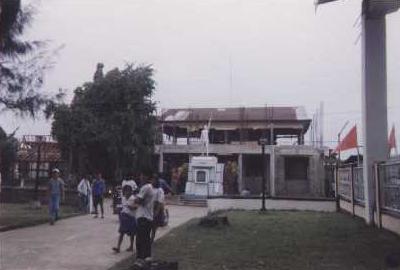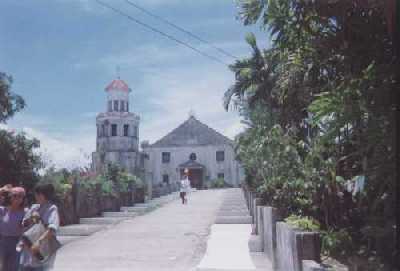Official historical markers are supposed to highlight the history of the buildings or places where they are displayed. However, the markers installed in buildings associated with the Balangiga Massacre in 1901 can confuse the ordinary readers with misleading statements and obvious omissions.

for the attack on September 28,1901 stands on the monument for the Balangiga Massacre.
Balangiga monument and marker
A monument in honor of Capitan Valeriano Abanador now stands in front of the municipal building of Balangiga. Abanador was the overall leader of the native fighters who attacked Company C of the U.S. Ninth Infantry Regiment in this town on September 28, 1901. This monument was erected in the early 1980s by the people of Balangiga through popular subscription initiated by the Balikatan sa Kaunlaran ng Balangiga (literally, Sharing Shoulders for the Progress of Balangiga) and the Historical Committee of the Balangiga natives residing in Metro-Manila.
The construction of the monument preceded the enactment of Republic Act No. 6692 in 1989, which designated September 28 of every year as "Balangiga Encounter Day" in the province of Eastern Samar. This piece of legislation is a fitting tribute to the heroism, courage and strong sense of patriotism of the Balangigans.
In 1982 the National Historical Institute (NHI), through the representation of Balangiga natives in Metro-Manila, authorized a historical marker "to honor national heroes and perpetuate the glory of their deeds and to preserve historical sites."

The text of the marker was written in Tagalog. The nearest English translation is as follows:
BALANGIGA MASSACRE
In this town, on the 28th of September 1901,
Filipinos armed with bolos attacked Company "C",
Ninth Infantry of U.S. They killed almost all
the American soldiers. In revenge the Americans
launched a six-month "kill-and-burn" [campaign].
The town became like a "howling wilderness."
Because of their cruelty, Brig. Gen. Jacob H. Smith
and Major Littleton W.T. Waller were tried by
court martial and cashiered.
Comments
It has been established that there were more American survivors of the Balangiga Massacre than what the native attackers had thought. Native accounts mentioned only about seven or nine American survivors who escaped on native bancas from Balangiga. American reports accounted a total of 26 survivors.
The "kill-and-burn" campaign lasted much less than six-months, but it covered the entire southern part of Samar, not just Balangiga.
Gen. Smith was retired from the U.S. Army. But Major Waller rose to eventually become Major General of the U.S. Marines.

Balangiga church marker
In 1993 the National Historical Institute installed a historical marker in front of the Balangiga church. The nearest English translation of the Tagalog inscription is as follows:
CHURCH OF BALANGIGA
Built out of stone inside
a fortified patio with four
turrets by the Jesuit priests in
the 17th century under the patronage
of San Lorenzo. Rebuilt by Fr.
Cristobal Miralles, 1653. Extension church (visita) of
Guiuan, 1773. Repaired by Fr. Manuel
Valverde, 1850. Became a town, April
3, 1854; parish, September 27, 1859.
Here, the revolutionists gathered
to await the ringing
of the bell as signal to
start the strike (pag-aaklas) in Balangiga
against the Americans, September
28, 1901. Rebuilt, 1927; repaired
and beautified, 1962-1993.

from the 1999 commemorative program of the Balangiga Encounter Day.
Comments
The early Jesuits in the Leyte-Samar region built wooden churches. But the text of the Balangiga church marker suggests that the original church was made of stone before being rebuilt by Fr. Miralles, also a Jesuit, in 1653.
The opposite seems to be true. I speculate that the original church of Balangiga was made of wood. After its destruction, probably during a Moro raid, the church was rebuilt as a stone structure described in the marker.
Dr. Bruce Cruikshank provides some notes about Balangiga in his book, Samar: 1768-1898. Balangiga was listed as a pueblo with its own Augustinian parish priest in 1770, but from 1773 onward was listed as pueblo dependent upon Guiuan or Basey for a priest. It had its own gobernadorcillo (i.e., mayor) at least as early as 1814, although Buzueta in 1851 mentioned it was ecclesiastically and politically part of Guiuan. Huerta said Balangiga was a visita (extension church) of Guiuan until its ecclesiastical and political separation on April 3, 1854.
The second to the last sentence of the marker pertains to an event that made Balangiga famous. Inside the church, a group of Filipino freedom fighters awaited the ringing of the church bell, the signal to attack the Americans stationed in this town in the morning of Sept. 28, 1901. The marker implied only one bell, not two.
Historians continue to debate the term used for the fighting in Balangiga. The Americans originall called it a "massacre" of U.S. soldiers. A Philippine legislation officially called it an "encounter." Others have termed it a "battle" and, most recently, a "raid." But the NHI inscribed the word "strike" (pag-aaklas) for the marker, which is a very tepid term.
The last sentence in the marker mentioned that the Balangiga church was rebuilt in 1927. There is no mention that it was burned by American reinforcement troops the day after the successful attack of the Filipinos.

Basey church marker
In 1987 the NHI installed a historical marker in front of the church of Basey town in western Samar (just across Tacloban). The English translation of the Tagalog text is as follows:
CHURCH OF BASEY
Former parish of the Jesuits
under the Diocese of Cebu in 1591
and the House of Dagami in 1656.
Erected with firm foundation
by the Jesuits and dedicated to Saint
Michael Archangel. Transferred to the
Augustinians, 1768, and to the Franciscans,
1795; but taken possession in
1804. Repaired and construction with [bell] tower
and convent of stone-and-coral along
with the cemetery and chapel by Father
Domingo de Madrid, 1845 [,] destroyed by a typhoon,
1880. Roof was changed with galvanized iron
by Father Vicente Gutierrez,
1896. Had been a mission station,
center for teaching the
Christian doctrine. And fort - era of
Spaniards; hall for public meetings and
[stage] plays - during the Japanese occupation; and
place of refuge - during Liberation [in 1944].

Comments
It is established fact that Basey was a former parish of the Jesuits, first under the Diocese of Cebu (in 1591) and later of the Jesuit House in Dagami (central Leyte) in 1656. But the next statement in the marker, "erected with firm foundation by the Jesuits" probably refer to another structure, now called the Buscada Church, about a kilometer away from the present church on the hilltop.
The Buscada Church is the parent church of Tacloban (in Leyte) and the origin of the Tacloban's revered Santo Niño icon. Tacloban's creation as a barrio of Basey dates back to the 1770s.
The present hilltop church has a façade with an obvious Fransciscan motif. In contrast, the Buscada Church appears to have a Jesuit ambience (i.e., with layers of tombs for walls made out of coral stone blocks).
The repair work mentioned in the marker's succeeding statements appears to pertain to the hilltop church building.
The reference to mission station and center for teaching of the Christian doctrine, which were professed Jesuit activities, probably apply to the Buscada Church. The rest of the statements apply to the church on the hilltop.
A serious omission in the Basey church marker is the complete absence of reference to the Philippine-American War in the area. The convent adjacent to the Basey Church was the headquarters and hospital of the U.S. Ninth Infantry around the time of the attack on Company "C" in Balangiga on Sept. 28, 1901. A month later, the convent became the headquarters and hospital of a battalion of U.S. Marines under the command of Major Littleton W.T. Waller, which was attached to the Sixth Separate Brigade under Brig. Gen. Jacob H. Smith with southern Samar was area of responsibility. This Marine battalion was tasked with turning southern Samar into a "howling wilderness."
Towards the end of 1901, the U.S. Marines undertook a "forced march" across the jungle of southern Samar, from Lanang in the east coast to Basey in the west, in their effort to break the back of the Filipino resistance. After their arrival in Basey, the tired, sick and weary Marines, who lost 10 of their comrades during the march, executed by firing squad their nine remaining conscripted native carriers and two guides.
Major Waller ordered the execution of the "11 Martyrs of Basey" from his sickbed in the Basey convent.
According to then U.S. President Theodore Roosevelt, "the shooting of the native bearers by the orders of Major Waller was an act that sullied the American name."
